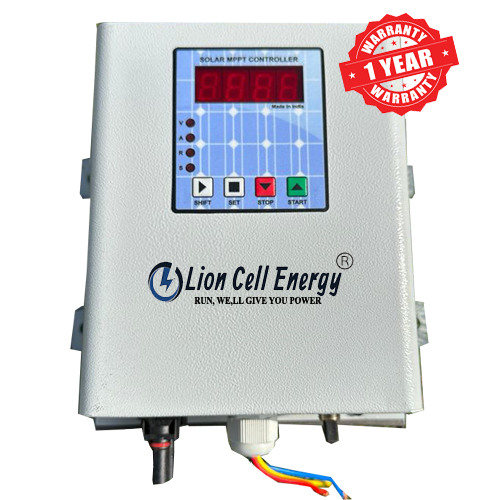What is an MPPT Solar Charge Controller?
In the world of solar energy, maximizing the efficiency of solar panels is key. One way to achieve this is through the use of an MPPT (Maximum Power Point Tracking) Solar Charge Controller. This device plays a crucial role in ensuring that the energy captured from solar panels is used in the most effective way possible.
Unlike traditional charge controllers, MPPT controllers adjust the voltage of the solar panels to match the battery charging needs, providing up to 30% more efficiency in converting sunlight into usable energy.
How Does an MPPT Solar Charge Controller Work?
An MPPT Solar Charge Controller continuously monitors the output of the solar panel array. It tracks the maximum power point – the voltage and current combination that produces the most energy – and adjusts the system to operate at this point.
This is especially important because the output of solar panels fluctuates based on factors like temperature, sunlight, and panel age. By adjusting to the most efficient voltage, MPPT controllers help maximize energy production and ensure faster battery charging.
Key Benefits of MPPT Solar Charge Controllers:
- Increased Efficiency: MPPT controllers can increase energy production by up to 30%, particularly in variable sunlight conditions.
- Battery Life Optimization: They help to regulate the charging of batteries, preventing overcharging and extending the lifespan of your solar energy storage.
- Better Performance in Low Light: MPPT controllers are particularly effective in low-light or cloudy weather, where traditional controllers may struggle.
- Faster Charging: MPPT charge controllers can charge batteries faster than conventional controllers, making them ideal for systems that require quick energy storage.
Choosing the Right MPPT Solar Charge Controller
When selecting an MPPT charge controller for your solar setup, it’s essential to consider factors like:
- Rated Capacity: Choose a controller with the appropriate capacity for your system’s energy needs.
- Compatibility: Ensure that the controller is compatible with your battery type and solar panels.
- Efficiency Rating: Look for controllers with higher efficiency ratings to get the most out of your solar investment.
- Temperature Range: Make sure the controller can operate in the temperature range typical of your location.
Common Applications of MPPT Solar Charge Controllers:
Agricultural Solar Applications: Farmers are using solar energy to power irrigation systems, cooling units, and other farm equipment. MPPT controllers help ensure efficient use of solar energy.
Residential Solar Systems: Homeowners looking to reduce electricity bills often use MPPT charge controllers in their solar setups for better energy management.
Off-Grid Solar Systems: These systems, which are used in remote locations without access to the main power grid, rely heavily on MPPT controllers to optimize solar energy collection.
Electric Vehicles (EV): As solar-powered EVs gain traction, MPPT controllers are becoming a crucial part of the energy management systems.
MPPT Controller: The perfect companion for your solar energy investment
A smart addition to your solar investment—whether you’re powering your home, an off-grid cabin, or using solar energy for vital agricultural needs like running a water pump in the fields.—it’s important to understand the role of the MPPT controller. It’s not just about knowing some complex technical terms; it’s about making the most of your investment in your solar energy system and getting reliable power from it.
Simply put, the MPPT controller is the brains behind getting the most power out of your solar panels. It ensures that your panels work at their best potential at all times, especially when sunlight varies. This allows you to get the most power from your system, charge your batteries faster, and make your entire system work more efficiently. This is why it is so important in making sure your solar energy investment is safe and effective.
What is MPPT solar charge controller designed for?
MPPT stands for Maximum Power Point Tracking. It is not just a catchy name but a very smart technology.
Your solar panels are like an engine. Just like an engine has a specific speed (RPM) where it produces the most power, solar panels have a specific “maximum power point This represents the optimal blend of voltage and current that allows the panel to generate its peak power.
The MPPT controller finds this particular point and exposes the panel to that point, so that you get maximum energy from the sunlight. This ensures that your solar panels always work to their best potential, even when the sunlight is low or the weather is changing. That is why it is so important for your solar power system.
The Undeniable Advantages: Why MPPT Controllers Outperforms
When you compare MPPT controllers to their simpler counterparts, you will immediately see the benefits, especially when you consider the long-term performance and return on investment (ROI) of your solar power system.
Advantages of MPPT controller: some special cases
Cold weather: Cooler temperatures can actually boost the efficiency of solar panels by helping them generate higher voltage and operate more effectively. The MPPT controller efficiently reduces this higher voltage to charge the battery, and converts the remaining voltage into more current.
Low Battery Charge: When your batteries are almost empty, the MPPT controller delivers maximum current, allowing charging to occur much faster.
Partial shade or cloudy days: Even when the sunlight isn’t fully visible, the MPPT controller continuously searches for and captures the best power point, ensuring you still get the most energy possible.
Great flexibility in system design
MPPT controllers are extremely versatile. They allow you to use solar panels that have a voltage much higher than that of your battery bank. For example, you can connect 60-cell or 72-cell grid-tie solar panels, which have higher typical voltages, to a 12V or 24V battery bank.
This flexibility often has the following benefits:
You can use more economical and easily available panels.
You can also simplify your wiring by running higher voltage wiring over longer distances with less power loss.
Extend battery life
The MPPT controller also helps to increase the battery life as it is adept at charging properly.
There are several stages of battery charging, such as bulk (fast charging), absorption (almost fully charged), and float (fully charged). The MPPT controller provides the correct voltage and current to the battery at each of these stages.
By doing this, there is no unnecessary pressure on the battery. This protects the battery from overcharging and undercharging, both of which are major causes of early battery failure.
Robust Performance in Diverse Conditions:
Unlike PWM controllers, which can become less efficient when there is a large difference between panel voltage and battery voltage, MPPT controllers perform well under a wide range of environmental conditions.
Be it scorching heat or freezing cold, and bright midday sun or foggy afternoon, they are always trying to extract maximum power.
Diving Deeper: Understanding MPPT Controllers from Product Examples
Looking at specific product series such as “Solar Pump MPPT Controller” gives us a practical understanding of the use of these devices. Products like Solar Pump MPPT Controller 1 HP, 2 HP, 3 HP, 5 HP and 7.5 HP focus on directly powering solar powered water pumps This makes a big difference in agriculture and remote areas, where reliable and efficient energy is essential.
“HP” (horsepower) ratings indicate the power of the pump motor for which these controllers are designed. This means that these controllers are designed to meet the specific voltage and current requirements of different sizes of pump motors. This ensures that solar powered water supply is efficient.
Moreover, the lineup extends to “Hybrid” models, exemplified by the Apollo Pump MPPT Controller 2 HP Hybrid, 3 HP Hybrid, 5 HP Hybrid, and 7.5 HP Hybrid. These “hybrid” controllers may feature an AC input. This means that when solar power is not available (such as at night or during long cloudy periods), the solar pump can draw power from the grid or a generator.
How to Choose the Right MPPT Controller: Key Considerations
When you are looking to buy an MPPT solar charge controller, pay special attention to the following:
System voltage: First, see if the controller is designed to work with the voltage of your battery bank (e.g. 12V, 24V, 48V).
Maximum PV input voltage (Voc): This is very important. Add up the open-circuit voltage (Voc) of all your solar panels. This total voltage should be less than the maximum PV input voltage specified by the controller. Also be aware of cold weather, as it can increase Voc for some time.
Maximum PV Input Power: The total power (total watts) of your solar system must not exceed the maximum input power specified by the controller.
Maximum charge current: This indicates the maximum current (in amperes) the controller can deliver to your battery. Make sure this is enough for the size of your battery and the speed you need to charge it.
Efficiency rating: To minimise energy loss, look for controllers that have a high conversion efficiency, typically 90-99%.
⚙️ How Does MPPT Work?
🔄 Step-by-Step Working:
- Solar Panel Produces Power
The solar panel generates power based on sunlight. The voltage may be higher than the battery voltage. - MPPT Controller Measures Output
The controller continuously monitors panel voltage and current to determine the Maximum Power Point (MPP). - DC-DC Conversion
Using a buck converter, it converts higher voltage from the panel to a lower voltage suitable for charging the battery, while increasing the current to maintain power (P = V × I). - Battery Charging
It charges the battery efficiently with adjusted voltage/current without wasting excess power.
⚡ MPPT vs PWM Comparison:
| Feature | MPPT | PWM |
|---|---|---|
| Efficiency | 96-99% | 70–80% |
| Cost | Higher | Lower |
| Voltage Flexibility | Yes (higher panel voltage) | Must match battery voltage |
| Ideal For | Large or cold/winter systems | Small systems, warm weather |

